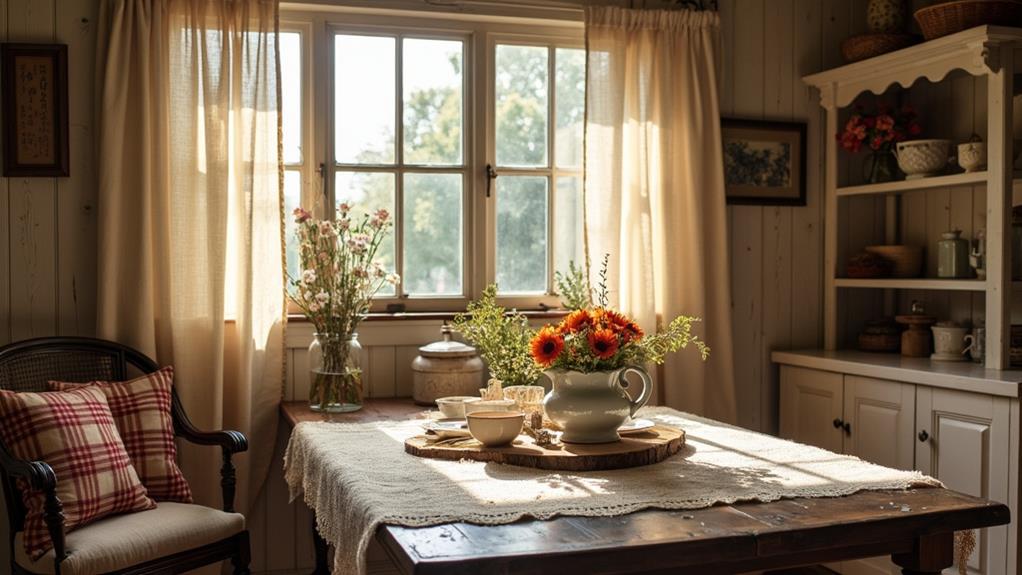Farmhouse fabrics fuse simplicity with functionality, epitomizing a rustic aesthetic that thrives on natural fibers like cotton and linen, known for their durability and cozy appeal. Burlap and gingham are quintessential, with burlap offering earthy texture, while gingham's simplicity pairs well with diverse patterns. Linen and cotton duck bring sturdy yet stylish options, softening and gaining character over time. For cooler climates, tweed and wool provide warmth and rich texture. Emphasizing sustainability, these fabrics balance practicality with eco-conscious choices. Thoughtful selection and care guarantee longevity, enhancing modern decor with texture and warmth. Exploring further reveals more about integrating these materials.
Table of Contents
ToggleUnderstanding Farmhouse Fabrics
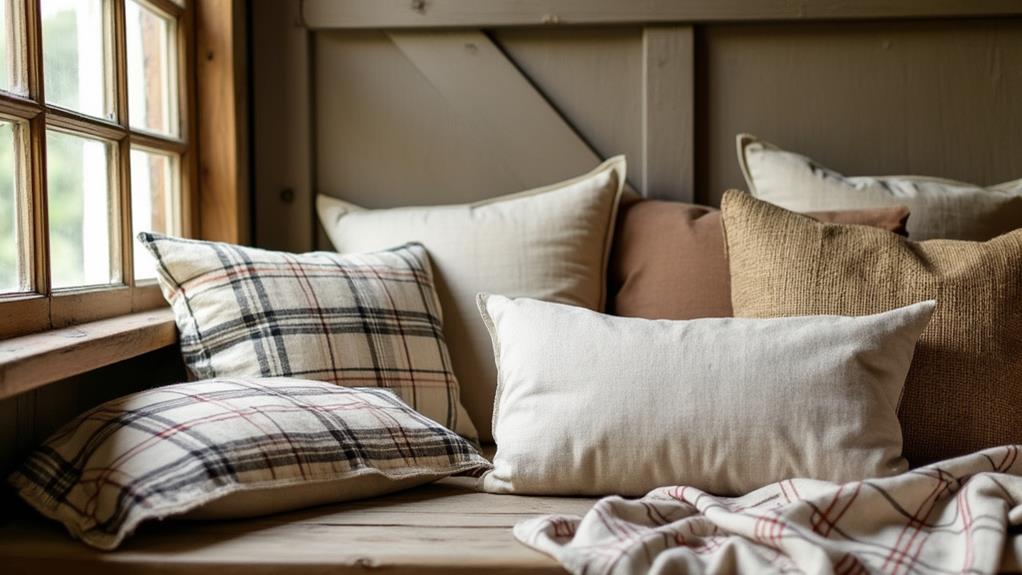
When it comes to understanding farmhouse fabrics, you'll find that they beautifully blend simplicity with functionality, all while reflecting a pastoral lifestyle.
These fabrics are crafted from natural fibers like cotton and linen, providing both durability and aesthetic appeal. They create a cozy atmosphere, enhancing the rustic retreat vibe inherent to farmhouse design.
Versatility is a key feature; you can dress these textiles up or down, mix or match them, forming the foundation of the farmhouse aesthetic.
Textures play an essential role, weaving warmth and authenticity into your home.
Additionally, the emphasis on sustainability underscores the importance of natural materials in your design choices, fostering a harmonious balance between practicality and environmental consciousness.
Essential Fabric Types
Diving into the world of farmhouse fabrics, you'll uncover key types that define this timeless aesthetic.
Burlap stands out with its natural, earthy texture and neutral tones, offering durability and sophistication.
Gingham, a classic pattern, provides simplicity and versatility, pairing well with floral prints or solids.
Linen, made from flax fibers, showcases organic beauty through subtle creases and a gentle drape, softening with each wash.
Tweed, known for its warmth and texture, is ideal for colder months, often used in upholstery and throws.
Cotton duck, a heavyweight plain-woven cotton, brings sturdiness and adaptability, creating a comfortable backdrop for designs.
These essential fabric types form the cornerstone of a cozy, rustic farmhouse environment.
Unique Fabric Qualities
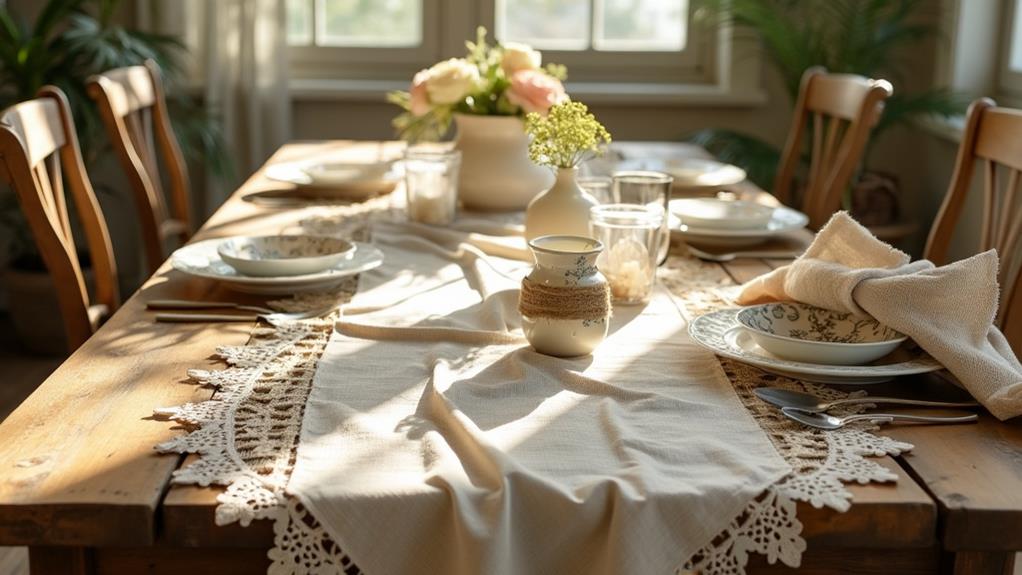
Explore the charm of unique farmhouse fabrics that bring individuality and character to your space. These fabrics, such as hessian, muslin, and calico, each offer distinct qualities that can enhance your home's aesthetic.
Hessian provides a refined texture and eco-friendly appeal, making it perfect for sustainable design elements. Muslin, with its airy and lightweight nature, softly filters light and complements diverse decor styles.
Meanwhile, calico's playful floral prints offer versatility for upholstery and quilts, allowing for creative pattern mixing. Chambray adds understated elegance with its denim-like softness, while wool contributes warmth and rich texture, essential for cozy environments.
Selection and Care Tips
Choosing the right farmhouse fabrics for your home involves understanding their durability, maintenance needs, and aesthetic appeal.
Start by considering where the fabric will be used, as durability is vital for high-traffic areas. Natural fibers like cotton and linen offer resilience and age gracefully, making them ideal for everyday use.
Maintenance is equally important; opt for fabrics that are easy to clean, such as those that allow for spot cleaning or gentle washing. Regular care, including dusting and vacuuming, extends the life of your textiles.
It's important to familiarize yourself with care instructions specific to each material, ensuring you preserve their beauty and functionality.
Combining Fabrics With Modern Decor
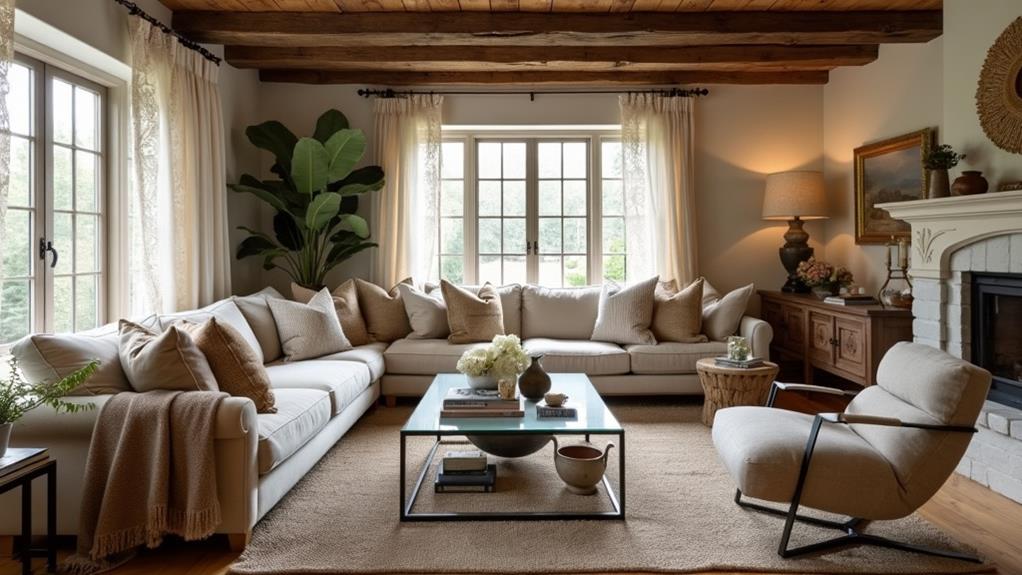
After selecting the right farmhouse fabrics for durability and maintenance, you can start blending them with modern decor to create a harmonious living space.
Begin by choosing a cohesive color palette, mixing neutral tones with modern accents. Consider integrating chambray or gingham for subtle patterns that enhance contemporary styles. Use burlap or hessian for texture, balancing sleek furniture with rustic charm.
Pairing linen with metallic or glass elements adds sophistication while maintaining a natural aesthetic. Focus on layering different materials—like cotton duck and tweed—to create depth and interest.
Verify the space remains unified by repeating fabric patterns or colors in accessories, such as cushions or curtains. By combining these elements thoughtfully, you'll achieve a seamless blend of farmhouse warmth and modern elegance.
Texture and Warmth in Design
Incorporating farmhouse fabrics into your home design infuses spaces with texture and warmth, creating an inviting atmosphere.
These textiles, often crafted from natural fibers like cotton, linen, and wool, offer durability and aesthetic appeal. The tactile quality of fabrics like burlap and tweed enriches interiors, while linen's gentle drape and subtle creases add an elegant touch.
Gingham and calico introduce visual interest with their patterns, balancing simplicity and nostalgia. Choosing materials with varied textures enhances the cozy, rustic feel, making rooms more comfortable and visually appealing.
Sustainable Fabric Choices
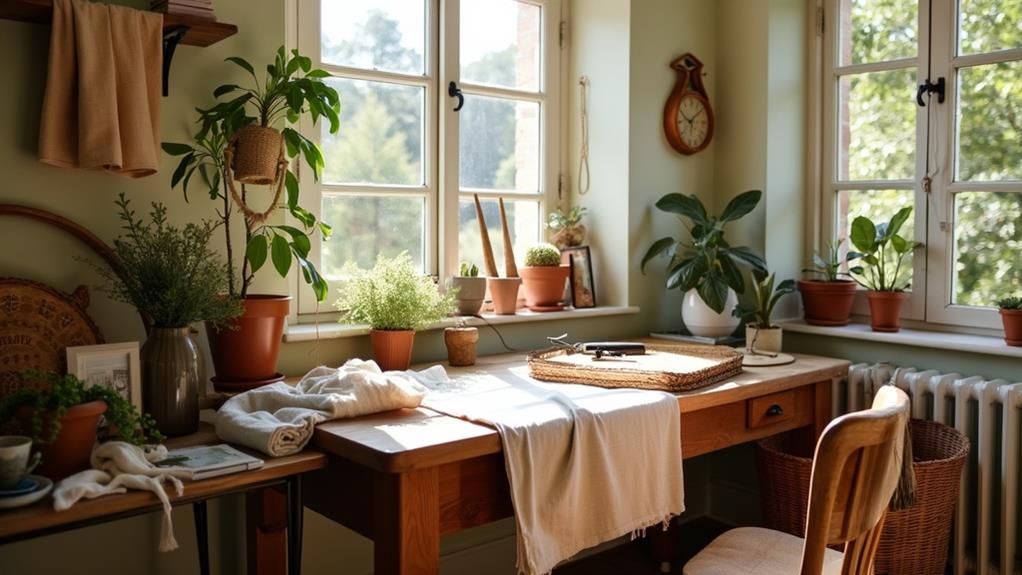
When selecting fabrics for your home, prioritizing sustainability is both a responsible and stylish choice.
Opt for materials like organic cotton and linen, which aren't only durable but also environmentally friendly. These fabrics are crafted using fewer pesticides and chemicals, reducing their ecological footprint.
Wool is another excellent option, as it's biodegradable and offers natural insulation.
Consider reclaimed or recycled textiles, which give new life to existing fibers, minimizing waste.
Hemp is a strong, versatile fabric that requires less water to grow, making it a sustainable alternative.
Focus on sourcing from ethical producers who guarantee fair wages and environmentally sound practices.

